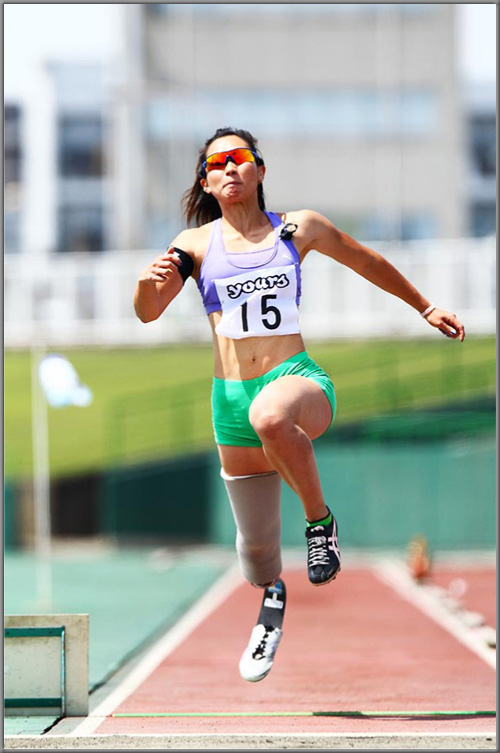Home > Highlighting JAPAN > Highlighting Japan OCTOBER 2011 > Nakanishi Runs and Jumps into Record Books
Highlighting JAPAN
COVER STORY: Japan’s Women on Top of the World
Caption: Maya Nakanishi holds Japanese national records for athletes with a prosthetic foot
in the 100- and 200-meter sprint, and long jump events. There are few female amputee athletes
anywhere in the world who compete in three events at the top level.
Credit: ©TAKAO OCHI/KANPARA PRESS
Nakanishi Runs and Jumps into Record Books
Amputee athlete Maya Nakanishi hopes to build on her track-and-field triumphs in Japan by taking a medal or two at the 2012 London Paralympics. The Japan Journal’s Osamu Sawaji reports.

Maya Nakanishi (No. 1702) competes in the 100-meters at the Beijing 2008 Paralympic Games. Nakanishi placed sixth in the final.
Credit: ©TAKAO OCHI/KANPARA PRESS
Nakanishi remembers, “Not only could I not play tennis; at first, I couldn't even walk properly on the prosthetic leg, so I got really depressed.”
At that time the leading Japanese manufacturer of prosthetic legs for sports suggested that she switch to track-and-field, so she began practicing short distance running. When she did, she improved incredibly quickly, setting Japanese records for the 100- and 200-meter sprints in a mere six months.
Then, on September 14, 2008 at the Beijing 2008 Paralympic Games, Nakanishi became the first Japanese woman to be at the start line in a 100-meter race. By coincidence that day was exactly two years after her accident. She ran 13.93 seconds in the qualifying heat, breaking her own Japanese record, and placed sixth in the final. Moreover, she placed fourth in the 200-meter race.
But Nakanishi wasn’t at all satisfied with these results.
“Since I had never lost in Japan, I underestimated what it would be like against the rest of the world,” says Nakanishi. “I realized very keenly that if I were to put myself in the tough international environment, unless I strengthened myself mentally, I would never be able to win there.”
She decided to go to the United States, and in 2009 started training based at the National Olympic Training Center in San Diego, California. There she met her current coach, Al Joyner, who coached her in the 100- and 200-meter sprints, and the long jump. One and a half months after her training began, in her first competition as a long jumper, she jumped to a new Japanese record of 4 m 71 cm. After more training, she has improved to reach her best jump of 4 m 96 cm, which is only 13 cm away from the world record.
“I’m the smallest of the female track-and-field athletes with a prosthetic leg (at 158 cm). So at competitions abroad, the other athletes and spectators are really surprised when I beat the tall competitors. It’s a really satisfying feeling,” laughs Nakanishi. “Al says he has no doubt I’m going to set a world record. So I really want to break the world records in all three events for sure.”
Participating in next year’s London Paralympics is a big goal for Nakanishi. But an athlete's life is a busy one. Finding sponsors, preparing to travel to and enter competitions, among other things, she has to do all by herself. In addition, when she makes return trips to Japan, she is very receptive to requests to give lectures, do interviews, and run sports classes for children.
“I want to raise awareness about sport for persons with a disability in Japan, and establish it as a culture rooted in our society,” says Nakanishi. “I feel as if I have to pave the way for athletes with a disability who come after me.”
© 2009 Cabinet Office, Government of Japan






